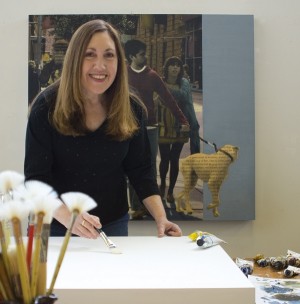Sherry Karver’s “Flash Fiction” Exhibition Combines Photography, Painting, and Fiction Writing
Sherry Karver isn’t your ordinary people-watcher. While many people may wonder about the life stories of those they pass on crowded city streets, Karver takes her observations a bit further than most. She creates her own “biographies” of strangers and shares them in her artwork.
Flash Fiction is Karver’s third solo exhibition at the Kim Foster Gallery in New York. The pieces in the showcase remove the anonymity of strangers in a crowd and swiftly incorporate photography, painting and fiction; to create the stories of people we may have never given a second glance.
“We each have a voice. We each have a story to tell. I’m focusing on how we stand out from that sea of sameness and get heard as individuals,” Karver shared in a phone interview.
The creative process behind Karver’s project is bountiful in detail, employing many steps to incorporate the three mediums used in her pieces. She begins her work by photographing crowds of people in black and white. According to Karver, during this fundamental step, she may capture hundreds of images. Once she has gathered all the images she desires, she heads back to her studio where the real handiwork begins.
Digitally editing the photographs, she adds her own text biographies into the images, creating stories and giving a new life to the people encapsulated forever in the stillness of the frame. The images are then adhered to wood panels, on top of which Karver delicately hand-paints several layers of oil glazes to add color. Yet the production does not end there. The sides of the panel are also painted to create a wrap-around look that matches the photograph. Once everything is dry, Karver finalizes the pieces by covering them in a resin pour, giving them a reflective quality that can create the illusion of the viewer within the work.
“I’m combining the old master technique of oil-glazing with contemporary digital photography,” Karver said.
The pieces in Flash Fiction are all images of Grand Central Station in New York City, though Karver has captured many other settings for the same process. However, the setting is obscured, almost becoming irrelevant, as it is the people in motion that are the main focus of Karver’s work. The images lose their defined edges with the layers of oil glaze Karver adds, becoming more painterly and blurred. This produces the effect that these strangers could be anyone—even one of us.
Kim Foster, the gallery’s curator and namesake, explained her attraction to Karver’s work.
“I like pieces with a story, and I’m very text oriented, so I like a good narrative,” she said. “Sherry’s paintings have a good narrative. As with most of the art in my gallery, there’s a story behind it.”
“There are several pieces that I respond to for different reasons,” Foster added. “She tried something new in a piece called First Impressions. It doesn’t have a story on each person, but just one word—one word that says quite a bit about that person. I am also drawn to The Quality of Human Nature, the largest piece in the show, in which there are tons of people and you are looking down on a crowd in Grand Central.”
Experiencing Karver’s work is interactive and almost voyeuristic; it is as if the viewer is reading multiple diaries, or the minds of passersby. Secrets, as well as quirks, both funny and endearing in nature, are revealed in Karver’s writing. The strangers in her work quite literally become an open book.
“By reading it, I think the viewer has a chance to experience the artwork and to become part of my process,” Karver explained.
(Article continued on next page)

